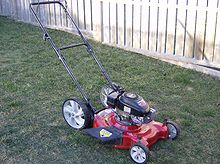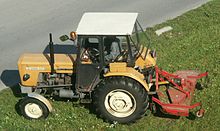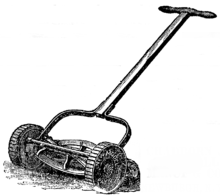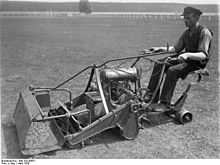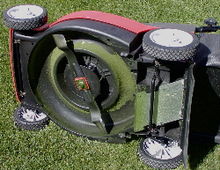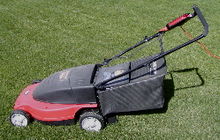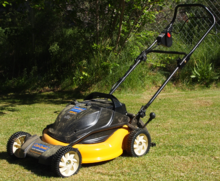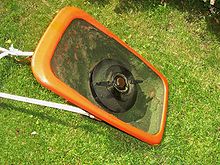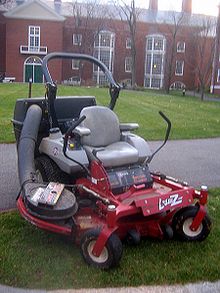- Lawn mower
-
- For agricultural mowers see Mower
A lawn mower is a machine that uses a revolving blade or blades to cut a lawn at an even length.
Lawn mowers employing a blade that rotates about a vertical axis are known as rotary mowers, while those employing a blade assembly that rotates about a horizontal axis are known as cylinder or reel mowers.
Many different designs have been made, each suited to a particular purpose. The smallest types, pushed by a human, are suitable for small residential lawns and gardens, while larger, self-contained, ride-on mowers are suitable for large lawns, and the largest, multi-gang mowers pulled behind a tractor, are designed for large expanses of grass such as golf courses and municipal parks.
Contents
History
See also: History of the lawnCylinder mowers
The first lawn mower was invented by Edwin Budding in 1827 in Thrupp, just outside Stroud, in Gloucestershire. Budding's mower was designed primarily to cut the lawn on sports grounds and extensive gardens, as a superior alternative to the scythe, and was granted a British patent on August 31, 1830.[1] It took ten more years and further innovations to create a machine that could be worked by animals, and sixty years before a steam-powered lawn mower was built. The first machine produced was 19in in width with a frame made of wrought iron. The mower was pushed from behind with the motive power coming from the rear land roller which drove gears to transfer the drive to the knives on the cutting cylinder; the ratio was 16:1. There was another roller placed in between the cutting cylinder and the land roller which was adjustable to alter the height of cut. On cutting, the grass clippings were hurled forward into a tray like box. It was soon realized, however, that an extra handle was needed in front of the machine which could be used to help pull it along. Two of the earliest Budding machines sold went to Regent's Park Zoological Gardens in London and the Oxford Colleges.[2] In an agreement between John Ferrabee and Edwin Budding dated May 18, 1830, Ferrabee paid the costs of development, obtained letters of patent and acquired rights to manufacture, sell and license other manufacturers in the production of lawn mowers.
These early machines were all made of cast iron and featured a large rear roller with a cutting cylinder (a "reel") in the front. Cast iron gear wheels transmitted power from the rear roller to the cutting cylinder. Overall, these machines were remarkably similar to modern mowers.[3] Without patent, Budding and Ferrabee were shrewd enough to allow other companies to build copies of their mower under license, the most successful of these being Ransomes of Ipswich which began making mowers as early as 1832.[3] In the middle of the decade, Thomas Green and Son of Leeds introduced a mower called the Silens Messor (meaning silent cutter), which used chain to transmit power from the rear roller to the cutting cylinder. These machines were lighter and quieter than the gear driven machines that preceded them, although they were slightly more expensive.[3]
Thomas Green produced the first chain-driven mower in 1859. Manufacture of lawn mowers began in the 1860s. By 1862, Farrabee's company was making eight models in various roller sizes. He manufactured over 5000 machines until production ceased in 1863. The first United States patent for a reel lawn mower was granted to Amariah Hills on January 12, 1868. .[4] In 1870, Elwood McGuire of Richmond, Indiana designed a human-pushed lawn mower, which was very lightweight and a commercial success. John Burr, an African American, patented an improved rotary-blade lawn mower in 1899, with the wheel placement altered for better performance. Amariah Hills went on to found the Archimedean Lawn Mower Co. in 1871. Around 1900, one of the best known English machines was the Ransomes' Automaton, available in chain- or gear-driven models. JP Engineering of Leicester, founded after World War I, produced a range of very popular chain driven mowers. About this time, an operator could ride behind animals that pulled the large machines. These were the first riding mowers. In 1902, Ransomes produced the first commercially available mower powered by an internal combustion gasoline engine. In the United States, gasoline powered lawn mowers were first manufactured in 1919 by Colonel Edwin George. .[4]
The rise in popularity of lawn sports helped prompt the spread of the invention. Lawn mowers became a more efficient alternative to the scythe and domesticated grazing animals. James Sumner of Lancashire patented the first steam-powered lawn mower in 1893. His machine burned petrol and/or paraffin (kerosene) as fuel. These were heavy machines that took several hours to warm up to operating pressure.[5] After numerous advances, the machines were sold by the Stott Fertilizer and Insecticide Company of Manchester and, later, Sumner took over sales. The company they controlled was called the Leyland Steam Motor Company. Numerous manufacturers entered the field with petrol (gasoline)-driven mowers after the turn of the century. The first grass boxes were flat trays but took their present shape in the 1860s. The roller-drive lawn mower has changed very little since around 1930. Gang mowers, those with multiple sets of blades, were built in the United States in 1919 by a Mister Worthington. His company was taken over by the Jacobsen Corporation, but his name is still cast on the frames of their gang units.
Atco Ltd - The First Motor Mower
In the 1920's one of the most successful companies to emerge during this period was Atco, at that time a brand name of Charles H Pugh Ltd. The Atco motor mower, launched in 1921 was an immediate success. Just 900 of the 22in cut machines were made in 1921, each costing £75. Within five years, annual production had accelerated to tens of thousands. Prices were cut and a range of sizes was available, making the Standard the first truly mass produced motor mower.
Main article: Atco LtdRotary mowers
Rotary mowers were not developed until engines were small enough and powerful enough to run the blades at a high speed. Many people experimented with rotary blades in the late 1920s and early 1930s, and Power Specialties Ltd. introduced a gasoline-powered rotary mower. Kut Kwick replaced the saw blade of the “Pulp Saw” with a double-edged blade and a cutter deck, converting the “Pulp Saw” into the first ever out-front rotary mower.[6] One company that produced rotary mowers commercially was the Australian Victa company, starting in 1952: these mowers were lighter and easier to use than the mowers that came before. The first Victa mowers were made at Mortlake (Sydney) by local resident Mervyn Victor Richardson. He made the first out of scrap in his garage and then moved to a shed behind St Mary's Church of England, where the first Victa mowers were manufactured and went on sale on 20 September 1952. The new company, Victa Lawnmowers Pty Ltd, was incorporated on 13 February 1953. The venture was so successful that by 1958 the company moved to much larger premises in Parramatta Road, Concord and then to Milperra.[7] Two Victa mowers, from 1958 and 1968 respectively, are held in the collection of the National Museum of Australia.[8] The Victa mower is regarded as something of an Australian icon, appearing en masse at the opening of the Sydney Olympic Games in 2000.
Types of lawn mowers
By rotation
Cylinder or Reel mowers
The cylinder mower carries a fixed, horizontal cutting blade at the desired height of cut. Over this is a fast-spinning reel of blades which force the grass past the cutting bar. Each blade in the blade cylinder forms a helix around the reel axis, and the set of spinning blades describes a cylinder.
Of all the mowers, a properly adjusted cylinder mower makes the cleanest cut of the grass,[9] and this allows the grass to heal more quickly. The cutting action is often likened to that of scissors; however, it is not necessary for the blades of the spinning cylinder to contact the horizontal cutting bar.[9] If the gap between the blades is less than the thickness of the grass, a clean cut can still be made.If more however the grass will slip through.
There are many variants of the cylinder mower. Push mowers (illustrated) have no engine and are used on small lawns. As the mower is pushed along, the wheels drive gears which rapidly spin the reel. Typical cutting widths are 10 to 16 inches (410 mm).
The basic push mower mechanism is also used in gangs towed behind a tractor. The individual mowers are arranged in a 'v' behind the tractor with each mower's track slightly overlapping that of the mower in front of it. Gang mowers are used over large areas of turf such as sports fields or parks.
A gasoline engine or electric motor can be added to a cylinder mower to power the cylinder, the wheels, the roller, or any combination of these. A typical arrangement on electric powered machines for residential lawns is for the motor to power the cylinder while the operator pushes the mower along. The electric models can be corded or cordless. On petrol machines the engine drives both the cylinder and the rear roller. Some variants have only three blades in a reel spinning at great speed, and these models are able to cut grass which has grown too long for ordinary push mowers.[9] One type of reel mower, now largely obsolete, was a powered version of the traditional side-wheel push mower, which was used on residential lawns. An internal combustion engine sat atop the reel housing and drove the wheels, usually through a belt. The wheels in turn drove the reel, as in the push mower.
Greens mowers are used for the precision cutting of golf greens and have a cylinder made up of at least eight, but normally ten, blades. The machine has a roller before and after the cutting cylinder which smooths the freshly cut lawn and minimizes wheel marks. Due to the weight, the engine also propels the mower. Much smaller and lighter variants of the roller mower are sometimes used for small patches of ornamental lawns around flower beds, and these have no engine.[9]
Riding reel mowers are also produced. Typically, the cutting reels are ahead of the vehicle's main wheels, so that the grass can be cut before the wheels push the grass over onto the ground. The reels are often hydraulically powered.
Rotary mowers
A rotary mower rotates about a vertical axis and tend to be used for a rougher cut, however some modern rotaries are fitted with a rear roller to provide a more formal striped cut. These machines will also tend to cut lower (13mm) than a standard 4 wheeled rotary.
By energy source
Gasoline (petrol)
Most rotary push mowers are powered by internal combustion engines. Such engines are usually four-stroke cycle engines, running on gasoline (petrol) or other liquid fuels. Internal combustion engines used with lawn mowers normally have only one cylinder. Power generally ranges from two to seven horsepower (1.5 to 6.75 kW). The engines are usually carbureted and require a manual pull crank to start them, although electric starting is offered on some models. Some mowers have a throttle control on the handlebar with which the operator can adjust the engine speed.[10] Other mowers have a fixed, pre-set engine speed. Gasoline mowers have the advantages over electric mowers of greater power and distance range. They do create pollution from the gas in the engine.[11] and their engines require periodic maintenance such as cleaning or replacement of the spark plug and air filter.[12][13]
Electric
Electric mowers are further subdivided into corded and cordless electric models. Both are relatively quiet, typically producing less than 75 decibels, while a gasoline lawn mower can be as loud as 95 decibels or more.[14]
Corded electric
Corded electric mowers are limited in range by their trailing power cord, which may limit their use with lawns extending outward more than 100-150 feet from the nearest available power outlet. There is the additional hazard with these machines of accidentally mowing over the power cable, which stops the mower and may put users at risk of receiving a dangerous electric shock. Installing a residual-current device (GFCI) on the outlet may reduce the shock risk. On the United States market as of summer 2008, a corded electric mower from a respectable manufacturer costs about the same as an entry-level internal-combustion mower ($150–200), with significantly higher reliability, significantly lower cost of ownership, and a significantly reduced carbon footprint.[15]
Cordless electric
Cordless electric mowers are powered by a variable number (typically 1-4) of 12 volt rechargeable batteries. Typically more batteries mean more run time and/or power. Batteries can be in the interior of the lawn mower or on the outside. If on the outside the drained batteries can be replaced with recharged batteries. Cordless mowers have the maneuverability of a gasoline powered mower and the environmental friendliness of a corded electric but are more expensive and come in fewer models (particularly self-propelling) than either. Disposal of worn-out batteries may negate the environmental advantages, and the motors in cordless mowers tend to be less powerful than gasoline motors of the same total weight (including batteries).
Other Notable Types
Hover mowers are powered rotary push lawn mowers that use an impeller above the spinning blades to drive air downwards, thereby creating an air cushion that lifts the mower above the ground. The operator can then easily move the mower as it floats over the grass. Hover mowers are necessarily light in order to achieve the air cushion and typically have plastic bodies with an electric motor. The most significant downside, however, is the cumbersome usability in rough terrain or on the edges of lawns, as the lifting air-cushion is destroyed by wide gaps between the chassis and the ground. Hover mowers are built to operate on steep slopes, waterfronts, and high-weeded areas so they are often used by golf courses and commercial landscapers. Grass collection is often available, but can be poor in some models. The quality of cut can be inferior if the grass is pushed away from the blade by the cushion of air.
A robotic mower is contained by a border wire around the lawn that defines the area to be mowed. The robot uses this wire to locate the boundary of the area to be trimmed and in some cases to locate a recharging dock. Robotic mowers are capable of maintaining up to 5 acres (20,000 m2) of grass. Robotic lawn mowers are increasingly sophisticated, are usually self-docking and contain rain sensors, nearly eliminating human interaction for mowing grass. Multiple robotic mowers can be used to mow an even larger area.
Riding mowers (U.S. and Canada) or ride-on mowers (U.K.) are a popular alternative for large lawns. The operator is provided with a seat and controls on the mower and literally rides on the machine. Most use the horizontal rotating blade system, though usually with multiple blades.
A common form of ride-on mower is the lawn tractor. These are usually designed to resemble a small agricultural tractor, with the cutting deck mounted amidships between the front and rear axles.
The drives for these mowers are in several categories. The most common transmission for tractors is a manual transmission. The second most common transmission type is a form of continuously variable transmission called the hydrostatic transmission. These transmissions take several forms, from pumps driving separate motors, which may incorporate a gear reduction, to fully integrated units containing a pump, motor and gear reduction. Hydrostatic transmissions are more expensive than mechanical transmissions but they are easier to use and can transmit greater torque to the wheels as compared to a typical mechanical transmission. The least common drive type, and the most expensive, is electric.
There have been a number of attempts to replace hydrostatic transmissions with a lower cost alternative, but these attempts, which include variable belt types (e.g., MTD's Auto Drive) and toroidal, have various performance or perception problems that has caused their market life to be short or their market penetration to be limited.
Riding lawnmowers can often mount other devices such as rototillers/rotavators, snowplows, snowblowers, yard vacuums, occasionally even front buckets or fork-lift tines.
The deck of a rotary mower is typically made of steel. Lighter steel is used on less expensive models, and heavier steel on more expensive models for durability. Other deck materials include aluminum, which does not rust and is a staple of higher priced mowers, and hard composite plastic, which does not rust and is lighter and less expensive than aluminum. Electric mowers typically have a plastic deck.
Riding mowers typically have an opening in the side or rear of the housing where the cut grass is expelled. Some have a grass catcher attachment at the opening to bag the grass clippings. Special mulching blades are available for rotary mowers. The blade is designed to keep the clippings circulating underneath the mower until the clippings are chopped quite small. Other designs have twin blades to mulch the clippings to small pieces. This function has the advantages of forgoing the additional work collecting and disposing grass clippings while reducing lawn waste in such a way that also creates convenient compost for the lawn, forgoing the expense of fertilizer.
Mower manufacturers market their mowers as side discharge, 2-in-1, meaning bagging and mulching or side discharging and mulching, and 3-in-1, meaning bagging, mulching, and side discharge. Most 2-in-1 bagging and mulching mowers require a separate attachment to discharge grass onto the lawn. Some side discharge mower manufacturers also sell separate "mulching plates" that will cover the opening on the side discharge mower and, in combination with the proper blades, will convert the mower to a mulching mower. These conversions are impractical when compared with 2- or 3-in-1 mowers which can be converted in the field in seconds. There are two types of bagging mowers. A rear bag mower features an opening on the back of the mower through which the grass is expelled into the bag. Hi-vac mowers have a tunnel that extends from the side discharge to the bag. Hi-vac is also the type of grass collection used on some riding lawn mowers and lawn tractors and is suitable for use in dry conditions but less suitable for long wet lush grass as they just clog up. Mulching and bagging mowers are not well suited to long grass or thick weeds. In some ride-on mowers, the cut grass is dropped onto the ground and then collected by a set of rotating bristles, allowing even long, wet grass to be collected.
Rotary mowers with internal combustion engines come in three price ranges. Low priced mowers use older technology, smaller motors, and lighter steel decks. These mowers are targeted at the residential market and typically price is the most important selling point. These mowers are sold through large discount and home improvement stores, range between $100–400 on the US market, and have a typical service life of 7–10 years. Higher priced mowers are also primarily targeted at residential customers. These mowers have more features and often have heavier steel, composite plastic or aluminum decks. Most of these mowers are sold through independent dealers who also service the equipment and cost between $200 and $1000. These mowers will last as long as twenty years given regular maintenance. Commercial grade mowers are the most expensive rotary mowers. They are "targeted" at grounds maintenance companies and other professionals, but are commonly sold to home owners as well. These mowers feature the latest technology and include features such as disk drive, oil filters, and very heavy steel and, more often, aluminum decks. These mowers are sold through independent dealers who service the product and, with regular maintenance, they have a service life far beyond twenty years. A commercial grade mower typically costs from $4,000 to as much as $90,000.
Professional grass-cutting equipment (used by large establishments such as universities, sports stadiums and local authorities) usually take the form of much larger, dedicated, ride-on platforms or attachments that can be mounted on, or behind, a standard tractor unit (a "gang-mower"). Either type may use rotating-blade or cylindrical-blade type cutters, although high-quality mowed surfaces demand the latter. Wide-area mowers (WAMs) are commercial grade mowers which have decks extended to either side, many to 12 feet (3.7 m). These extensions can be lowered for large area mowing or raised to decrease the mower's width and allow for easy transport on city roads or trailers.
Safety issues
Rotary mowers can throw out debris with extreme force. In addition, the blades of self-powered push mowers (gasoline or electric) can injure a careless or inattentive operator; as such, many come equipped with a dead man's switch to immediately stop the blade rotation when it is not being operated. In the US, over 80,000 people per year are hospitalized due to mower accidents.[16] The vast majority of these injuries can be prevented by wearing protective footwear when mowing. The American Academy of Pediatrics recommends that children must be at least 11 years old before they can mow.[17]
Environmental impact
A 2001 study showed that some mowers produce the same amount of pollution (emissions other than carbon dioxide) in one hour as driving a 1992 model vehicle for 650 miles (1,050 km).[18] Another estimate puts the amount of pollution from a lawn mower at four times the amount from a car, per hour.[19] Beginning in 2011, the United States Environmental Protection Agency has set standards for lawn equipment emissions and expects a reduction of at least 35 percent.[20]
Mowers also create significant noise pollution,[21][22] and could cause hearing loss if used without hearing protection.[23]
See also
- Atco Ltd - Lawn & Garden Mowers
- Grasscycling
- Groundskeeping (includes list of equipment)
- Lawn mower racing
- Organic lawn management
- Roll over protection structure (for lawn tractors or ride-on mowers)
References
- ^ US RE 8560, Passmore, Everett G., "Improvement in Lawn-Mowers", published 23 February 1869, issued 28 January 1879; see pg 1, col 2. For a copy, see Google Patents copy. This source indicates the patent number as "6,080". According to "British patent numbers 1617 - 1852 (old series)", the patent number would have been assigned sometime after 1852 and taken the form of "6080/1830".
- ^ "The Hall & Duck Trust: Lawn Mower History Part 2". Hdtrust.co.uk. http://www.hdtrust.co.uk/hist02.htm. Retrieved 2011-04-23.
- ^ a b c The Old Lawnmower Club. "Mower History". The Old Lawnmower Club. http://www.oldlawnmowerclub.co.uk/mowinfo/mowhist.htm. Retrieved 2011-04-23.
- ^ a b mary bellis (2010-06-16). "Greener Pastures - History of the Lawn Mower". Inventors.about.com. http://inventors.about.com/library/inventors/bllawns.htm. Retrieved 2011-04-23.
- ^ "The History of the LawnMower". Thelawnmower.info. http://thelawnmower.info/history.php. Retrieved 2011-04-23.
- ^ kutkwick.com
- ^ "How do you sell a million mowers?". hawkey.id.au. http://hawkey.id.au/Victa%20History.php. Retrieved January 20, 2009.
- ^ Victa mowers and related items, National Museum of Australia
- ^ a b c d Hessayon, D.G. (2007) The Lawn Expert. Transworld Publishers, London. ISBN 978-0-903505-48-2. p.28/33
- ^ Snapper walk-behind mower parts catalogue[dead link]
- ^ Cheryl Springfels. "Pollution from gasoline-powered lawnmowers". Peoplepoweredmachines.com. http://www.peoplepoweredmachines.com/faq-environment.htm. Retrieved 2011-04-23.
- ^ "Instruction Manual", web: MMHome-PDF.
- ^ "OM, Black Bear ZTR", 2008, web: Dztr-manual.
- ^ Hollis, Scott. "Cordless electric lawn mowers: these battery-powered machines are clean, quiet and easy to maintain." Mother Earth News 209 (April-May 2005): 67(4). General Reference Center Gold. Gale. Fairfax County Public Library. 7 Apr. 2009.
- ^ Dore S. and Laursen A. (2008)Push for more efficient mowers, Metro
- ^ Costilla V. and Bishai D.M. (2006) Medical researchers: 80,000 injuries a year attributed to mower accidents, Landscape Management
- ^ "Mowing the Lawn is Not Child's Play" (Press release). American Academy of Pediatrics. 2008-05-30. http://www.aap.org/advocacy/releases/may06lawnmowersafety.htm. Retrieved 2008-09-02.
- ^ Mindfully.org (2001) Grass Cutting Beats Driving in Making Air Pollution
- ^ RCEQ Reducing Pollution from Small, Gas-Powered Engines
- ^ "EPA tightens lawn mower, motor boat emission rules". Reuters. 2008-09-05. http://www.reuters.com/article/environmentNews/idUSN0547157820080905.
- ^ "NPC Quiet Zone Newsletter Spring 2003". Nonoise.org. http://www.nonoise.org/quietlawn.htm. Retrieved 2011-04-23.
- ^ Cheryl Springfels. "Noise pollution and push lawn mowers, electric mowers, and gas mowers". Peoplepoweredmachines.com. http://www.peoplepoweredmachines.com/environment/mower-noise.htm. Retrieved 2011-04-23.
- ^ ocregister.com
Further reading
- Halford, David G. Old Lawn Mowers - Shire publications LTD. 1999.
External links
- Directory of manufacturers (dmoz)
- LIFE Mows the Lawn - slideshow by Life magazine
- National Museum of Australia Victa lawn mowers at the National Museum of Australia.
Garden tools Averruncator · Axe · Chainsaw · Cultivator · Earth auger · Edger · Garden fork · Trowel · Grass shears · Hedge trimmer · Hoe · Hori hori · Irrigation sprinkler · Lawn aerator · Lawn mower · Lawn sweeper · Leaf blower · Loppers · Mattock · Pickaxe · Pitchfork · Plough (plow) · Pruning shears (secateurs) · Rake · Riddle · Rotary tiller · Scythe · Spade · String trimmer · Watering can · WeederCategories:- Lawn mower
- Cutting tools
- English inventions
- Gardening tools
- Lawn care
- 1827 introductions
Wikimedia Foundation. 2010.

